QUACKERS
Elusive Sea Monsters
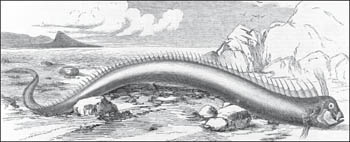
Unidentified things in the skies are called UFOs, but the ocean also has a category for mysterious sightings of marine beasts called USOs, or unidentified submerged objects. As technology advances, undersea realms and marine landscapes that were havens and retreats for creatures unnerved by encroaching civilization are now prodded and probed. In the Arctic and North Atlantic Oceans at depths never before observed, submarines registered unusual froglike noises, emitted by a creature that travels faster than any known man-made vessel, reaching speeds of 150 miles per hour before disappearing and leaving only a quack, or “ribbit,” sound in its wake. Giant squid, due to their lack of exoskeletons, often avoid sonar detection and emit a sound identified as a “bloop.” Orca whales also make audible undersea noises while mating, but do so close to the surface.
Renderings made from sonar signals created by the elusive quackers seem to resemble the long extinct basilosaurs, an elongated species of a whale, which once roamed the world’s oceans until thirty-four million years ago. Fossils of this creature were as long as 160 feet, with fins resembling paddles. It had a snout-shaped mouth with numerous sharklike teeth. In recent times, further investigation into the source of the frog sounds has driven the basilosaurlike beast, or whatever it is, only deeper into its underwater chambers. However, no specimen of the quacker has been located or positively identified.
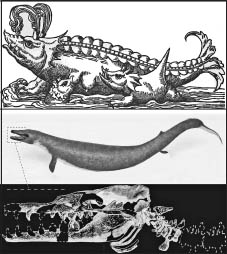
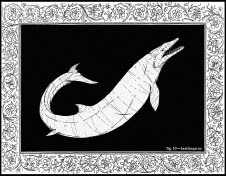
The quacker noises might be some counterintelligence technology, but the beast encountered was 60 feet long and resembled a torpedo-shaped shark.
QUETZALCOATLUS
Gigantic Gliding Dinosaur
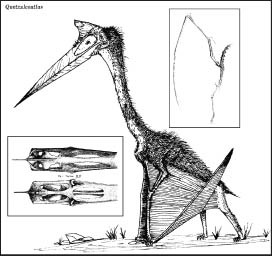
The first giant lizard that had powerful wings, Quetzalcoatlus cast ominous shadows during the dinosaur era, with some having 39-foot wingspans, bigger than some airplanes. The reptile belonged to a group of beasts known as pterosaurs. There were more than fifty different species. All had flaps of skin tissue that attached from their claws, ran along their bodies, connected at their feet, and served as wings, somewhat similar to bat anatomy. Pterosaurs had long, drawn-out, narrow heads, with rudder-type crests protruding from their skulls, with pointed, spikelike beaks and numerous sharp teeth. They had fur instead of feathers and attained flight by springing back on their legs and leaping into the air. Once up, they beat their wings furiously and were able to reach estimated speeds of over 75 miles per hour and soar for hundreds of miles. Most were carnivores, while some were scavengers, although the enormous Quetzalcoatlus found in North America apparently specialized in hunting fish. Their growth rate after hatching was supercharged, going from a flightless creature to one sturdy enough to fly within days. Pterosaurs lived from 220 million years ago, until 65 million years ago.
Still Flying?
No creature fits the descriptions of a dragon better than the pterosaur. The odd facts about this creature stem from cave drawings, particularly one drawn on a cliff face in Utah, made by Anasazi Indians in around A.D. 200—which was an exceedingly long time from when the flying reptiles were supposedly extinct.
Other pterosaurlike creatures supposedly have been seen in a wide range of locations, from Cuba and North Carolina to parts of Australia. In the mid-1800s, French workers were digging a tunnel. When they split open a boulder, a large birdlike beast emerged, spread its wings, groaned once, and then died. A local university identified it as a pterosaur, and a photo appeared in the 1856 edition of Illustrated London News. It is now known that a number of animals can “turn off” and enter various degrees of hibernation. Although it is extremely unlikely that any living thing could hibernate for sixty-five million years, nature and its rules are anything but constant.
In the last twenty years, beasts resembling Quetzalcoatlus were allegedly spotted in Papua New Guinea, where flocks of similar mysterious creatures come out at night so regularly natives gave them a name, “ropens.”
QUETZAL
Best-Dressed Bird

If all the birds in the world entered a beauty pageant, the quetzal, a tropical bird found in the Central American rain forest, might take the crown. The bird is 16 inches tall and a lightweight at about 8 ounces, with the male having a bright red breast, green wings, a shocking yellow beak, and a fluffy, chartreuse-hued crest. At mating season, the male grows a 3-foot rainbow-colored tail to score itself winning points in the bird beauty contest. The quetzal lives in tree hollows carved out with its beak and eats fruits, nuts, insects, and small lizards or frogs.
The bird was depicted frequently in Mayan and Aztec art, but people were forbidden to capture or to put the bird in cages, since it was said to lose its beauty and die of sadness if so imprisoned. If a person was found trying to tame one, the Mayans treated the offense with capital punishment. Today in Guatemala, the currency is not called dollars or pesos, but “quetzal,” in honor of the bird’s worth.
The Mayans and Aztecs venerated the quetzal as a goddess, and it was considered more precious than gold, representing a free-flying omen that brought good fortune to their civilizations.
QUINOTAUR
A Fishy Tale, Half Full of Bull
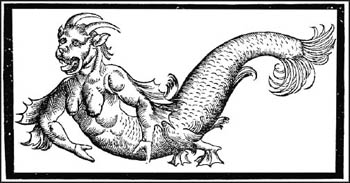
This fanciful beast became “extinct” by the eighth century and was rarely mentioned afterward. It was a mixture or a cross between a bull and a fish. Its bovine head had five horns, dark brown fur, and a large drool-dripping black nose. It dwelled in coastal regions near France. It was an amphibian and could disappear underwater and swim considerable distances before resurfacing. However, since its upper abdomen also had legs and hooves similar to those of a bull, it foraged on land, which must have been no easy task since it was forced to drag the lower, fishy part of its body about as well. When out of water, quinotaurs were most vulnerable to attack and reportedly were hunted to extinction. Ancients explained that it was borne from the union of a god and a human, but what this creature could have been remains unknowable. There are no related fossil records, and its existence relies on mentions of its habits in various mythologies, which seem similar to stories told of the Greek minotaur, though with a fishy twist.
